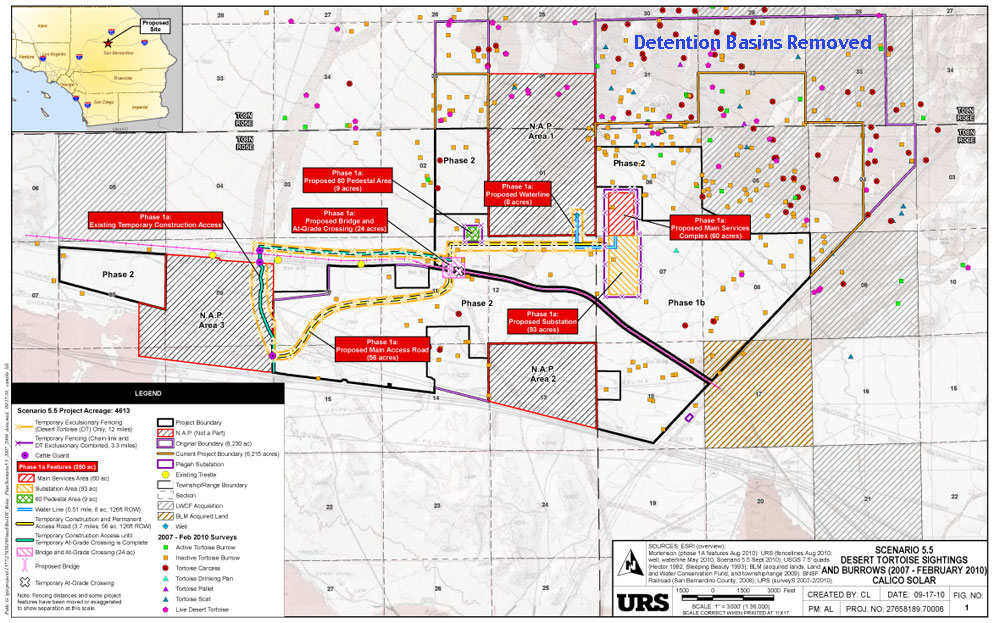Sierra Club Sues on Project Impacts
Tessera Sells Project to K Road
February 25, 2011 UPDATE >>here.
December 29, 2010 UPDATE - K Road Press Release:
K ROAD POWER ACQUIRES 850 MW CALICO SOLAR PROJECT
$3.0 Billion Project To Provide California with Clean, Reliable, Renewable Energy
San Diego, CA (December 28, 2010) – K Road Power Holdings, LLC ( “K Road”) announced today its wholly owned subsidiary K Road Sun, LLC has acquired the Calico Solar Project from Tessera Solar North America, Inc.
Calico Solar, located near Barstow, CA is one of California’s few fully permitted utility scale solar power facilities. Calico Solar has an interconnection agreement to supply 850 MW, enjoys strong support from the State of California and is well positioned to contract financeable power purchase agreements with California’s leading retail power suppliers. Total capital investment is estimated to be $3.0 billion. Once in operation the Calico Solar project will provide clean, reliable, California based renewable energy to meet the annual demand of up to 350,000 California households.
“While 100 MW of Phase 2 will be reserved for new generations of SES SunCatcher technology, K Road’s Calico Solar Project will convert the first 750 MWs to widely tested and accepted photovoltaic technology, insuring the project’s immediate financeability, further reducing environmental impacts, and providing the lowest cost solar production to help meet California’s renewable portfolio standard,” said William Kriegel, K Road’s founder and Chief Executive Officer.
K Road Sun is exclusively dedicated to developing, owning, and operating utility scale solar power facilities in the western United States. The K Road team has a unique, proven track record in power generation with decades of experience developing, constructing and operating generation plants worldwide, including solar, wind, biomass and hydro facilities. K Road believes that in order to be the lowest cost, most environmentally friendly source of sustainable energy, companies must be indifferent to technology and source production capacity from the most efficient, robust and economically viable sources.
K Road’s Managing Partner, Gerrit Nicholas added, “We are excited to move the Calico Solar Project into a financeable position, and we look forward to developing, constructing, and operating one of the world’s largest solar projects. In addition, we are pleased to play a role in creating economic opportunity for the Barstow community and helping society wean itself off of carbon based power supplies through environmentally advanced technology.”
Credit Suisse acted as financial advisors and Dewey LeBoeuf as legal advisors to K Road.
About K Road Power:
K Road Power is an independent power developer focused on developing, financing, owning and operating utility-scale solar projects in the southwest of the United States. Led by William Kriegel, K Road senior management is made up of long time power sector professionals from Sithe Energies and Goldman Sachs. Together K-Road principals, have a 25 year history of successfully developing and safely operating over 15,000 MW of conventional and renewable power assets, creating exceptional value for both shareholders and project stakeholders. Leveraging its experience in global power generation, K Road promotes sustainable, renewable energy development with a focus on reliability, and efficiency in concert with environmental and social responsibility.
Separately, K Road affiliate, K Road Solar, is active in the US Southwest working together with Native American Reservations to further economic development and energy independence through solar energy development. K Road Solar has over 1,500 MW of photovoltaic projects in various stages of development.
# # #
K Road Power Contact:
Anton Nicholas
K Road Communications
December 28, 2010 - Tessera Solar announced today that it had sold its Calico Solar Project to K Road, a coalition of developers Tessera's CEO Robert Lukefahr says in an announcement, "K Road is a group of highly experienced and highly successful power developers with a track record over several decades." He gave no details.
The announcement follows a report Monday that Southern California Edison had terminated its contract with Tessera to buy power from the Calico Solar project.
It wasn't immediately determined whether the two issues were linked.
A filing with the California Public Utilities Commission by Tessera last Thursday did not say whether it was Edison or Tessera that terminated the contract but an e-mail from Tessera spokeswoman Janette Coates said that Edison had terminated its Power Purchase Agreements with Calico. In discussing the PPAs, Coates said in her e-mail to the newspaper that "Calico Solar is a fully permitted facility, has an interconnection agreement for 850 MW and is pursuing alternative PPAs to assure its position as a key component of California's renewable energy future. That pursuit appears to have paid off quickly with the agreement to sell to K Road. Additionally, the e-mail bumped up the Calico generation capacity considerably from 660 MW, the figures provided yesterday through the Associated Press.
http://www.dailybulletin.com/news/ci_16959067
SoCal Edison Cancels PPA
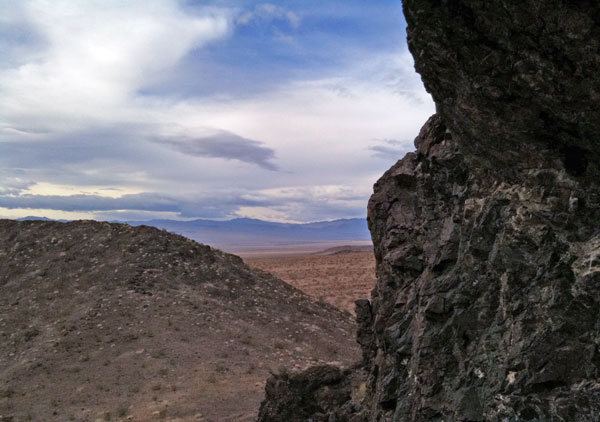
December 23, 2010 - Southern California Edison cancelled the agreement to purchase power from the proposed Calico solar thermal plant, which was supposed to created 663 megawatts of power.
Stirling, which has created a mirrored dish combined with a Stirllng engine that can generate 25 kilowatts of power, and Tessera, its developer, have been in a tailspin this month. Stirling CEO Steve Cowman and other executives departed and layoffs had occurred at Tessera. Right after that, NTR, the Irish parent company of both, said it would no longer invest in the projects.
http://www.sbsun.com/news/ci_16955170
http://www.desertdispatch.com/news/high-9989-newberry-project.html
California Energy Commission Grants Extension on Final Decision, Sierra Club Contemplates Lawsuit
December 1, 2010 - In a business meeting in Sacramento, the five Commissioners approved a Petition for Reconsideration by California Unions for Reliable Energy asking that the clock be restarted on the final decision because the decision was not made public for two weeks after the final vote, thus short-changing the public time to review the decision. A 30-day statute of limitations is required after the final decision is made for parties to be given the opportunity to file a Petition for Reconsideration of the CEC decision, or a Petition with the California Supreme Court (in filing a lawsuit).
Representatives of both CURE and Sierra Club were present to agree with the Commissioners that the official date of the final decision be moved from October 28 to December 1, thus restarting the clock. Sierra Club said they might be interested in filing a petition with the state Supreme Court, and wanted the procedures leading up to that clarified. Otherwise the Supreme Court would have to sort out the mistake made by CEC in posting the decision late. Sierra Club said they wanted all confusion removed.
CURE agreed, saying it was very important to have the full 30 days for parties to be able to make the decision on whether to file a petition. Commissioner Jeff Byron asked the CURE attorney whether they were going to file a petition with the Supreme Court. CURE said they had not decided yet.
Tessera, the applicant for the solar project, did not object to re-issuing a new Notice of Decision today.
Byron told the committee and public that he had met with both the president of CURE and executive director of the Sierra Club, perhaps in an attempt to head off litigation on the poorly-sited project.
Penning Tortoises In, Construction Goes Ahead
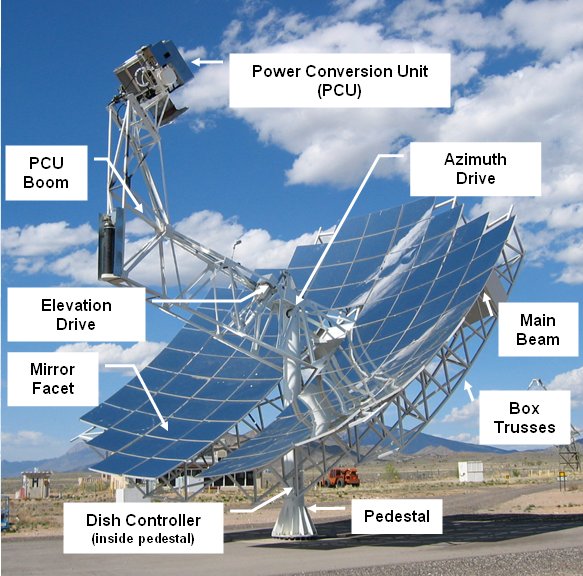
^These giant Stirling dishes ("SunCatchers") will be built in rows across the desert. In fall and winter 2010, 60 pedestals will be driven into the ground among potentially sleeping tortoises.
October 30, 2010 - The Tortoise Translocation Plan approved by agencies for this project is unprecedented in that it allows tortoises that go into hibernation underground after October to be fenced in over the winter while construction activities begin around them.
"Prior to construction of Phase 1a, 100% clearance surveys will be conducted within the area that is enclosed by exclusionary fencing to remove all tortoises from the impact area or exclusion fencing will be built around the burrow. Tortoises found in the Phase 1a footprint will be placed in quarantine pens in the adjacent area on the Calico Project site, depending on the date that the clearance survey is conducted. The flow chart below will be followed to determine the process. If occupied burrows are detected after October 31, the tortoises will be left in their burrows and a fenced quarantine pen will be constructed around each burrow; the pen will encompass the entire burrow, including the front apron and allow room for DETO to exit the burrow; approximately 3 square feet of open area extending from the outer edge of the burrow apron. The tortoises will be monitored and cared for during the winter based on the Animal Husbandry Plan prepared for this Project. If the tortoise comes out during the winter, it will be moved into the adjacent quarantine pen outside the Phase 1a boundary and held until spring; if it does not come out of the burrow it will be held until spring, when it will be disease-tested and translocated." (Final Plan Corrected Version October 14, 2010 - Desert Tortoise Translocation Plan Calico Solar Project, page 2-20)
Usually tortoise translocation activities cease at the end of October because temperatures become too cold and the animals go into hibernation deep in their burrows. But this year is full of exceptions to the rules. Clearance surveys will be allowed to go on until November 15, 2010 in Phase 1a, a 250-acre where the main access road and bridge over the railway will be built, the Main Services Complex, and 60 pedestals for SunCatchers.
The problem lies in the need to vibrate-drive these poles into the ground 18 feet to secure them against wind and flood scour as foundations for the giant 40-foot Stirling dishes. The Plan does not say exactly how big the fenced area will be around the tortoise burrow opening, but we have seen tortoises dig burrows 15 feet long, and the burrows can make unpredictable sharp turns and twists. How will workers know where a potential tortoise is underground? Plus there is the concern over the noise and disturbance of driving poles using vibration methods around the occupied burrows.
California Energy Commission Approves Troubled Calico Solar Project!
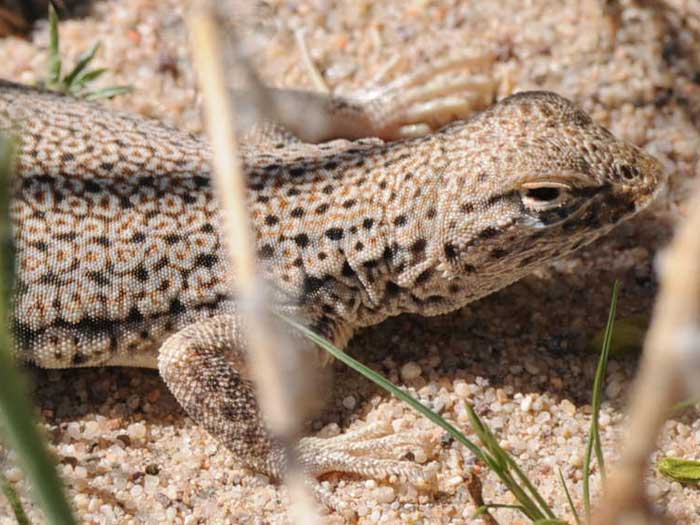
^These Mojave fringe-toed lizards (Uma scoparia) will be sacrificed. No mitigation is proposed but to acquire fringe-toed lizard habitat elsewhere in unspecified locations.
October 28, 2010 - After long comments that took all morning and into the afternoon, and including a deliberation behind closed doors with their legal counsel, the full five Commissioners voted to approve.
The California Energy Commission voted to license the Calico Solar Project despite large concerns with the lack of a final Tortoise Translocation Plan, blocking a bighorn sheep connectivity corridor, and wiping out an entire Mojave fringe-toed lizard population and one of two known populations of the rare plant White-margined penstemon in California (which should be federally protected). The draft Translocation Plan allows hibernating tortoises in their burrows to be fenced in and construction begun around them. This is unprecedented, and could damage long burrows and disturb animals due to the vibration-driving method chosen to place the poles into the ground that will hold the Stirling dishes.
BNSF still is demanding that debris/detention basins should be put in (they were removed), so that floods do not damage the railway. They had great concerns right up until the final vote, this section of their rail line was the main line connecting docks at Long Beach and Los Angeles with Chicago and points east. Commerce could be affected if an accident happened due to glint and glare, or flood damage to the track caused by the construction activities.
The lack of publicly-available plans for mitigating project impacts, the large number of deferred plans, wiould supposedly be covered by a stringent risk compliance program. If the developer failed to comply with numerous performance standards, the Energy Commission would theoretically shut the project down until it complied. This will allow Tessera Energy to begin construction of Phase 1A, 250 acres including their main access road, main services comples, and 60 pedestals to place SunCatcher dishes on in 2011, enabling the deadline to receive the 30% grant under the American Recovery and Reinvestment Act to be met. Tessera said it was still trying to obtain its Department of Energy loan guarantee.
The Commissioners did admit that the next round of solar projects needs to be sited on less ecologically sensitive habitats, and planned better.
One Commissioner also acknowledged that this was one of the more poorly sited large-scale solar projects, and many had grave concerns. But the benefits of reducing greenhouse gas emissions and providing jobs was said to outweigh all ecological and rail commerce concerns. One Commisssioner went so far as to say, "This project saves human lives," by reducing the health affects of burning fossil fuels. They talked of reducing the need to import foreign oil (although we note that electric car fleets are a long way from taking over California's freeways, so we are not sure how the need for oil will be lessened by this renewable energy project).
The project will generate 664 megawatts (nominal) of electricity on 4,600 acres of mostly public land, using 24,540 Stirling dishes.
BLM Issues Right-of-Way
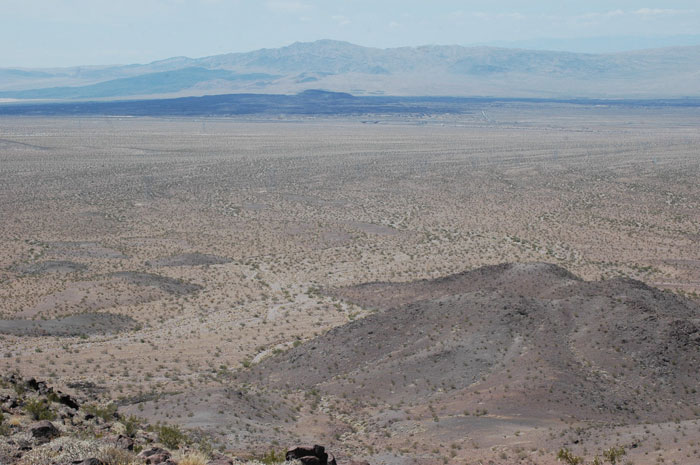
^Looking out over the project site from the Cady Mountains towards Pisgah Crater.
October 26, 2010 -
[Federal Register: October 26, 2010 (Volume 75, Number 206)]
[Notices]
[Page 65650]
From the Federal Register Online via GPO Access [wais.access.gpo.gov]
[DOCID:fr26oc10-87]
-----------------------------------------------------------------------
DEPARTMENT OF THE INTERIOR
Bureau of Land Management
[CACA 49537, LLCAD08000, L51030000, FX0000, LVRAM109AA03]
Notice of Availability of the Record of Decision for the Calico Solar Project and Associated Amendment to the California Desert Conservation Area Resource Management Plan-Amendment, San Bernardino County, CA
AGENCY: Bureau of Land Management, Interior.
ACTION: Notice of availability.
-----------------------------------------------------------------------
SUMMARY: The Bureau of Land Management (BLM) announces the availability of the Record of Decision (ROD) for a right-of-way (ROW) lease/grant to Calico Solar Limited Liability Corporation (LLC) for the Calico Solar Project (formerly SES Solar One) and an associated Amendment to the California Desert Conservation Area Resource Management Plan (CDCA Plan). The Calico Solar Project is located in San Bernardino County,
California. The Secretary of the Interior signed the ROD on October 20, 2010, which constitutes the final decision of the Department. The ROD and the Approved Plan Amendment are effective immediately.
DATES: These decisions are effective immediately upon publication of this notice.
ADDRESSES: Copies of the ROD are available upon request from the Field Manager, Barstow Field Office, Bureau of Land Management, 2601 Barstow Road, Barstow, California 92311 or at the following Web site: http://www.blm.gov/ca/st/en/prog/energy/fasttrack/calico/fedstatus.html or
http://www.blm.gov/ca/st/en/fo/barstow/solar_one_calico.html. Copies of the ROD are also available for public inspection at the Barstow Field Office.
FOR FURTHER INFORMATION CONTACT: Jim Stobaugh, National Project Manager, by telephone: 775-861-6478; mail: BLM Nevada State Office, P.O. Box 12000, Reno, Nevada 89520-0006; or e-mail: Jim_Stobaugh@blm.gov.
SUPPLEMENTARY INFORMATION: After extensive environmental analysis; consultation and collaboration with Federal, state, and local agencies; consideration of public comments; and application of relevant Federal laws and policies, the BLM has decided to offer Calico Solar LLC a ROW lease/grant for the construction, operation, maintenance, and
decommissioning of the 663.5 megawatt (MW), 4,604-acre Calico Solar Project, including related project facilities and access roads across public lands administered by the BLM. In association with this ROW lease/grant, the BLM is also amending the CDCA Plan to allow for the siting of a solar energy power plant on the proposed project site. The ROW lease/grant authorizes the use of public lands for the project for a term of 30 years, and the lease/grant is renewable. A temporary use permit authorizes the use of public lands for construction of temporary access roads and construction space for a term of 3 years and is also subject to renewal. The amendment of the CDCA Plan will allow for the siting of the Calico Solar Project and related facilities, including 26,450 SunCatcher solar dishes, a 230-kilovolt (kV) Calico Substation and 2-mile, 230-kv transmission line, and other project facilities through incorporation of the Calico Solar Project into the Energy
Production and Utility Corridors Element of the CDCA Plan. The BLM's decision authorizes issuance of a ROW lease/grant to Calico Solar LLC for the Modified Agency Preferred Alternative. The Agency Preferred Alternative is within the scope of alternatives that were analyzed in the Final Environmental Impact Statement (EIS) issued in August 2010.
Modifications to the Agency Preferred Alternative have been made since publication of the Final EIS as the result of additional agency consultation and in response to public comments.
The Environmental Protection Agency published a Notice of Availability (NOA) of the Final EIS in the Federal Register on August 6, 2010 (75 FR 47620). Publication of the NOA for the Final EIS initiated a 30-day protest period for the proposed amendment to the CDCA Plan. At the close of the protest period on September 7, 2010, five protests were received and resolved. Detailed information on the protests may be found on the BLM
Washington Office Web site at: http://www.blm.gov/wo/st/en/prog/planning/protest_resolution.html. The proposed amendment to the CDCA Plan was not modified as a result of the protest resolution.
Simultaneously with the protest period, the California Governor's Office conducted a 30-day consistency review of the proposed CDCA Plan amendment/Final EIS to identify any inconsistencies with state or local plan, policies or programs. The California Governor's office did not identify inconsistencies between the proposed amendment to the CDCA
Plan/Final EIS. As a result of the above and additional consultation with jurisdictional regulatory agencies, the 6,215-acre, 850-MW Agency Preferred Alternative for the Calico Solar Project was modified to include: (1) A project footprint reduced from 6,215 acres to 4,604 acres; (2) generation capacity reduced from 850-MW (34,000 SunCatchers)
to 663.5-MW (26,540 SunCatchers); and (3) construction of Phase 1 subdivided into phase 1a and 1b. The authorized ROW lease/grant includes all of the above modifications.
Because this decision is approved by the Secretary of the Interior, it is not subject to administrative appeal (43 CFR 4.410(a)(3)).
Authority: 40 CFR 1506.6.
Salazar Signs Calico Solar Project
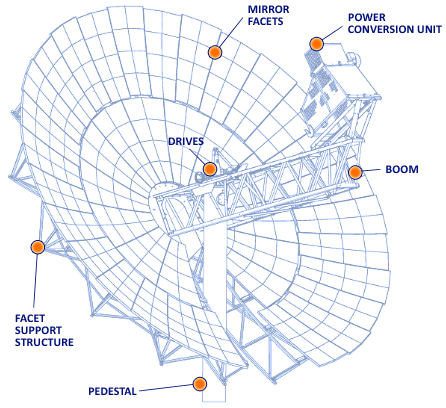
October 20, 2010 - Interior Secretary Ken Salazar signed the approval of Calico Solar Project, ahead of the California Energy Decision to license the 663.5 megawatt Stirling dish project on 4,604 acres of public lands managed by Bureau of Land Management. There will be approximately 30,000 dishes.
The Interior press release says: "Salazar noted that BLM significantly altered Tessera Solar’s project proposal to reduce its environmental impact. The project size was reduced from 8,230 acres to 4,604 acres to limit impacts on the desert tortoise and its habitat, reducing the number of tortoises affected from 107 down to 22. The smaller footprint also retains more than 1,600 additional acres of high-value wildlife habitat for desert tortoises, bighorn sheep and other wildlife along the foothills of the Cady Mountains."
Through the American Recovery and Reinvestment Act, renewable energy developers whose projects begin construction by the end of 2010 can apply for payments of up to 30 percent of the eligible costs of the project. Tessera Solar is also eligible to apply for significant funding through the Department of Energy’s Recovery Act conditional loan guarantee program.
We note that the project is still plagued by many problems with including lack of a Tortoise Translocation Plan available to the public, the continued blocking of wildlife movement corridors for Desert bighorn sheep, the find of a 10-12,000-year-old stone spearhead in land on site and no further archaeological investigations, no clear flood control plan, large concerns by BNSF whose track will be surrouned, and the destruction of one of two known populations in California of White-margined penstemon (the approval of this project will probably result in a push to list this species under the Endangered Species Act).
Department of Interior Press Release
http://www.desertdispatch.com/news/solar-9497-project-land.html
http://blogs.pe.com/news/digest/2010/10/interior-secretary-approves-so.html
http://www.mojavedesertblog.com/2010/10/blm-approves-calico-solar-power-project.html
Energy Commission Final Decision Seems Late
September 28, 2010 - The California Energy Commission announced that the final five Commissioner vote on the Presiding Member's Proposed Decision will happen on October 28. The applicant wants to be able to start 5% of its construction before December 31, 2010, to be able to get a Department of Energy guaranteed loan and American Recovery and Reinvestment Act grant to cover 30% of construction costs. But in order to do that they must move tortoises out of harm's way. US Fish and Wildlife Service only allows tortoises to by dug out of their burrows and moved in September and October, before the reptiles have gone underground for hibernation. It remains to be seen if the agnecy will allow acceptions and translocation to occur in November, when temperatures may be stressfully cold for the tortoises. Or perhaps Tessera Solar is contemplating taking advantage of the Safe Harbor provision where 5% of construction can begin off-site, in the factory. We will be watching.
"CALICO SOLAR PROJECT (08-AFC-13). Possible approval of the Presiding Member's Proposed Decision and possible Errata for the Calico Solar Project. The proposed project will be constructed on an approximate 4,613-acre site in San Bernardino County
approximately 37 miles east of Barstow, on lands managed by the Bureau of Land Management. The facility will produce a nominal 663.5 megawatts of electricity using SunCatcher technology."
http://www.energy.ca.gov/business_meetings/2010_agendas/agenda_2010-10-28.html
Science Ignored: Energy Commission Preliminary Approval Rushed Out
See Map enlargement.
September 25, 2010 - Late at night on the weekend, the California Energy Commission rushed to approve the Calico Solar Project, despite major unresolved problems with biological resources, visual impacts to the BNSF trains, and archaeological finds.
The approval is only preliminary, the two Commissioners who heard the case giving their Presiding Member's Proposed Decision, but the coming final vote by the full five Commissioners is sure to approve the license. Tessera Solar also needs to obtain its Right-of-Way approval from the Bureau of Land Management.
Two weeks ago the CEC was talking a major delay on the project. There were huge problems with more tortoises than any other project in California Department of Fish and Game history to give Section 7 consultation on, BNSF Railway was screaming about glare and flood danger to their track, the whole project was confused. Now, it suddenly gets preliminary approval.
The BNSF attorney at a workshop on September 9 was angry that this reduced alternative took out the detention basins at the top of the fan, so that Tessera could reduce the acreage without taking away too many SunCatchers, keeping the project at about 600 megawatts. BNSF asked what will stop floods from harming their track, now that all the desert pavement will be scraped up and more runoff will occur with development? This track is the busiest in the country, with hundreds of trains a day delivering goods from Los Anegeles docks to 1,000 cities back east. Endangering the safety of the railway could affect the economy. BNSF asked for a hydrology study to analyze the safety to their tracks without detention basins, but the study has not yet begun. BNSF maintains that placing 24,000 SunCatchers and hundreds of miles of new roads over the alluvial fan above the tracj will increase flow. The alluvial fan complex emanating from the Cady Mountains are active alluvial fans that possess extreme and high flood hazard potential all the way down to the BNSF right of way. Increased scour from placing SunCatchers in 1.5-foot deep washes would increase sediment flow towards the track, BNSF maintains.
Dr. Jim Andre, expert on the botanical riches of the desert, said, "The new configuration also does nothing to alleviate potential extinction of Penstemon albomarginatus in California, the poster-child rare plant of the Mojave Desert. When extinction doesn't matter, I'm not sure what does."
One of only two known populations in the state of White-margined penstemon is found on the project site, the other being in Ivanpah Valley.
Andre pointed out that hundreds of other vascular plants (10% of which are not yet described), cryptogamic plants, and 3,000 insect species on the project site alone (est. 15% are undescribed), will also be severly impacted.
A month ago, Tessera screamed that it could not reduce the acreage or megawatts of the project without endangering its Power Purchase Agreement with Southern California Edison. Suddenly the company is accepting a reduced alternative.
Presiding Member's Proposed Decision - Posted September 25, 2010 (PDF file, 712 pages, 14.5 megabytes)
Energy Commission Pushes Reduced Acreage Alternative for Calico
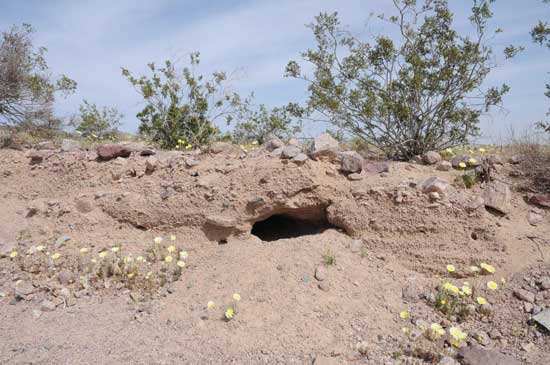
^Tortoise burrow on the Calico Solar Project site.
September 9, 2010 - At a workshop held in Sacramento, today, the California Energy Commission strongly urged Tessera Solar to adopt a drastically reduced alternative of 2,000 acres less, from 850 megawatts down to around 600 MW.
In an unusual statement, Commissioner Anthony Eggert, the presiding member, told the parties that in this project the committee has found that the benefits of the renewable energy that would be provided do not outweigh the impacts, especially to the Desert tortoise. Much of the project lies on high quality habitat.
This is a big setback for Tessera, who needs federal subsidies to be able to build the project, and those subsidies have deadlines. The Energy Commission license and Bureau of Land Management right-of-way need to be granted soon so that construction can begin in 2010. Even if the project were to move forward, the deadlines for translocating tortoises, determined by the US Fish and Wildlife Service, would be challenging to meet. usually all tortoises must be moved off the site before November when cold temperatures would unduly stress the animals. The final Tortoise Translocation Plan will not even be available for another few weeks.
Other setbacks to the project were shot by BNSF, whose railway goes through the middle of the project and would be surrounded by SunCatchers. A representative of BNSF reminded the parties that this particular artery is one of the main lines in the US, "and that is an understatement." He said a thousand cities depend on deliveries provided by the train in the eastern States for their daily needs. Hundreds of trains a week pass through the proposed Calico project site, as well as a weekly AmTrak train.
The issue was with Tessera's proposed elimination of detention basins from the project to try to meet the Energy Commission's demands. The detention ponds were originally designed to run along the northern edge of the project, above the BNSF track, to catch stormwater floods and control their peak flows downstream.
BNSF said safety of the trains and track was paramount on this extremely busy line. They expected detention basins, preferably just above the track. The BNSF representative said that they would expect "massive" stormwater loads of sediment during the first few years of project operation, because of construction removal of desert crusts that naturally slow runoff. Detention ponds would capture stormwater. He said that 34,000 "impervious surfaces" that do not exist today" have not been studied. He was referring to the large 40-foot tall SunCatcher dishes that will allow potentially increased rainwater runoff, metal surfaces replacing the present sponge-like desert pavement and biological soil crusts that absorb stormwater today. BNSF worried that the project would increase flood velocity pouring through the six underpasses along the track. They complained that no studies have been done in the rush to permit the project. "These are very, very, very real concerns to us," he said.
Tortoise Bombshell Causes Delay
September 3, 2010 - In a letter sent by the California Energy Commission, the Calico Solar Project may be delayed due to the very high number of tortoises unexpectedly found on the project site, more than any other current solar application.
"The Committee can not recommend approval of the Calico Solar Project as proposed by the Applicant due to the scope and scale of high quality habitat affecting desert tortoises and bighorn sheep that would be lost in order to construct and operate the project. That highest quality habitat exists in the portions of the proposed project site north of the Phase 1 boundary including the Phase 1 detention basins. The Committee is willing, if one or more parties are interested in pursuing the matter, to consider further evidence on project proposals with reduced footprints that exclude the highest quality tortoise habitat."
.......
"Depending on the scale and scope of the alternative(s) proposed, additional time for definition and analysis of reduced footprint alternatives may also assist the parties and
the Committee by allowing further consideration, analysis and development of the record on such points as:
--Project phasing and its interaction with various technical requirements;
--Balancing the removal of vegetation with dust suppression goals;
--Storm water drainage, including any necessary detention basins; and
--The appropriate level of testing of potential cultural resource sites."
(Letter dated September 3, 2010, COMMITTEE ORDER DIRECTING FURTHER REVIEW OF REDUCED FOOTPRINT ALTERNATIVES AND NOTICE OF COMMITTEE CONFERENCE)
Tessera Pulls Out of its Texas Project
Tortoise Translocation Does Not Work
August 25, 2010 - We thought the August 18 hearing would be the last, but some issues were so contentious that the California Energy Commission had to call another hearing which is occurring today in Sacramento.
Dr. Kristin Berry was invited to today's final CEC evidentiary hearing on the Calico Solar Project. She is a pre-eminent tortoise biologist with the United States Geological Survey, who began studying tortoises in 1970, and helped list the tortoise in 1990 under the federal Endangered Species Act. She gave testimony on her study plots:
1. Fort Irwin expansion project - she was involved in the translocation of 158 tortoises in March-April 2008. By December 2008, 43 were dead or dying, 15 missing. January 2009 - 100 alive, 15 missing. December 2009 - 27 more dead, 20 missing. Death rate 44.7%. January 2010 - 68 alive, 20 missing. To date 2010 - 8 more died, 23 missing.
Total mortality up to August 2010 - 49%, 23 missing. 11.6% death rate in 2010.
2. Daggett Mountains epidemiology study area, east of Barstow - 78 tortoises (no translocation) - plot 1: 2.5% mortality rate January-August 2010. Plot 2: zero deaths in 2010.
3. Soda Mountains study area (no translocation) - zero tortoise deaths.
Most Ft. Irwin deaths due to coyotes and dogs, as well as ravens. 2 vehicle kills on dirt roads, 1 rattlesnake kill, 1 Golden eagle kill, 1 death of gout, 1-2 died of hyperthermia. All mortality was among adult tortoises.
Conclusion: There is little evidence translocation is successful mitigation or minimization. The tortoise is not recovering.
Final Energy Commission Hearing
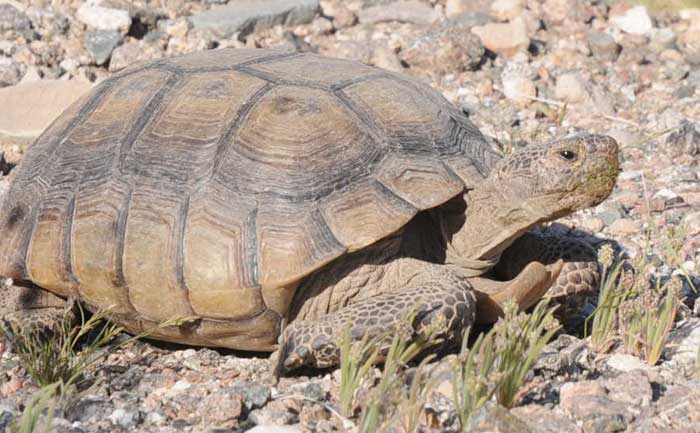
^Desert tortoise (Gopherus agassizii) dining on small annual plantain (Plantago ovata).
August 18, 2010 - The final California Energy Commission evidentiary hearing happens today in Sacramento. Issues covered will include visual resources, Land Use, Traffic, private property rights, and cultural concerns.
Biological issues have not been resolved, and may not be. Tessera Solar, on the recommendation of California Department of Fish and Game and US Fish and Wildlife Service, pulled their project back a half mile from the base of the Cady Mountains, supposedly to get out of rich tortoise habitat and allow for a movement corridor for tortoises. This reduced the project from 8,230 acres to 6,215 acres, but according to Tessera will not reduce the power output (850 megawatts), as the SunCatcher units would be moved closer together.
But Defenders of Wildlife expert Jeff Aardahl examined the data and found discrepancies in the applicant's tortoise numbers based on spring 2010 protocol surveys. Tessera claimed only 57 tortoises were left in the new project configuration, yet Aardahl carefully went through the maps and data and counted 104 tortoises, leading to an estimated population of 176 tortoises. 132 tortoises would be directly impacted, others would be in avoidance areas and would still have to be moved.
Aardahl said, "This is by far the largest number of individuals of this species that would be affected by any of the proposed renewable energy projects currently under permit review. In comparison, the next most-impacting proposed project, the Ivanpah SEGS, would directly impact at least 25 Desert Tortoises" (CEC evidentiary hearing, Barstow, August 5, 2010).
In addition the tortoises were healthy, and a large percentage of juveniles were found, indicating good reproduction. In contrast, some populations farther west in the Mojave have only large old adults and no juveniles detected (Dr. Kristine Berry, at May 2010 Ridgecrest Solar Power Project workshop).
Late in the game, Tessera came out with a proposed translocation plan to move all the tortoises off the project site in phases, starting in September or October 2010. Tortoises would be moved over the fence in some areas, to Pisgah Area of Critical Environmental Concern east of the project, and to the Ord-Rodman Desert Wildlife Management Area south of the project. Moving tortoises to such areas of critical habitat set aside for tortoise protection, as Ord-Rodman, was a precedent set by the massive Fort Irwin army base expansion, when tortoises were translocated. In that case, close to 40-50% of translocated tortoises died after being moved, from various causes, mostly coyote predation.
Many tortoise biologists and environment groups are now agreeing that translocation of desert tortoises does not work. Too many tortoises die. The original intent was to move tortoises from smaller linear right of ways, not gigantic blocks of land.
Other concerns would be to make sure sick tortoises are not moved into healthy populations. The applicant will carry out blood tests on tortoises moved over 500 meters.
BLM's Final Environmental Impact Statement Out
August 6, 2010 - In the Federal Register: Notice of Availability of the Final Environmental Impact Statement and Proposed Amendment to the California Desert Conservation
Area Plan for the Calico Solar (Formerly SES Solar One) Project, San Bernardino County, CA, by Bureau of Land Management.
SUMMARY: In accordance with the National Environmental Policy Act of 1969, as amended (NEPA), and the Federal Land Policy and Management Act of 1976, as amended (FLPMA), the Bureau of Land Management (BLM) has prepared a Proposed Resource Management Plan (RMP) Amendment/Final Environmental Impact Statement (EIS) for the Calico Solar (formerly SES Solar One) Project, San Bernardino County, California and for the
California Desert Conservation Area (CDCA) Plan and by this notice is announcing the availability of the Final EIS.
DATES: The publication of the Environmental Protection Agency's (EPA) Notice of Availability of this Final EIS in the Federal Register initiates a 30-day public comment period (see ADDRESSES section). In addition, the BLM's planning regulations state that any person who meets the conditions as described in the regulations may protest the
agency's Proposed RMP Amendment. A person who meets the conditions and files a protest must file the protest within 30 days of the date that the Environmental Protection Agency (EPA) publishes its notice in the Federal Register (see ADDRESSES section).
ADDRESSES: Please submit comments on the Final EIS to Jim Stobaugh, National Project Manager by mail: P.O. Box 12000, Reno, Nevada 89520; or e-mail: Jim_Stobaugh@blm.gov. Copies of the Proposed RMP Amendment/Final EIS are available for public inspection at the BLM Barstow Field Office, 2601 Barstow Road, Barstow, California 92311. Interested persons may also review the Proposed RMP Amendment/Final EIS at the following Web site: http://www.blm.gov/ca/st/en/fo/barstow/solar_one_calico.html. All protests of the Proposed RMP amendment must be in writing and mailed to one of the following addresses: Regular Mail: BLM Director (210), Attention: Brenda Williams, P.O. Box 66538, Washington, DC 20035. Overnight Mail: BLM Director (210), Attention: Brenda Williams, 1620 L Street, NW., Suite 1075, Washington, DC 20036.
FOR FURTHER INFORMATION CONTACT: Jim Stobaugh, BLM National Project Manager by mail: P. O. Box 12000, Reno, Nevada 89520; phone: (775) 861-6478; or e-mail: Jim_Stobaugh@blm.gov.
SUPPLEMENTARY INFORMATION: On March 14, 2007, Stirling Energy Systems (SES) Solar Six, Limited Liability Corporation (LLC) and SES Solar Three, LLC submitted applications for rights-of-way (ROW) grants to the BLM to construct and operate a concentrated solar thermal power plant facility on public lands in San Bernardino County, California. The two
ROW application areas were subsequently combined into one project (SES Solar One) proposed for an 8,230-acre site located immediately north of Interstate 40, approximately 37 miles east of Barstow, California. On December 2, 2008, SES Solar One, LLC (SES Solar Three, LLC and SES Solar Six, LLC) submitted an Application for Certification to the
California Energy Commission (CEC) to construct and operate the SES Solar One Project. In January 2010, the project name was formally changed to Calico Solar as a result of SES Solar Three, LLC merging with SES Solar Six, LLC to create Calico Solar, LLC. Calico Solar, LLC is a subsidiary of Tessera Solar. The BLM's purpose and need for the Calico Solar Project is to respond to the Calico Solar, LLC's application under Title V of FLPMA
(43 U.S.C. 1761) for a ROW grant to construct, operate, and decommission a solar thermal power facility on public lands in compliance with FLPMA, the BLM's ROW regulations, and other applicable Federal laws.
A joint state-Federal environmental Staff Assessment (SA)A/Draft EIS of the Calico Solar Project was prepared in accordance with a 2007 Memorandum of Understanding between the BLM California Desert District and CEC to conduct joint environmental reviews of solar thermal projects that are proposed on Federal land managed by the BLM. The joint environmental review was achieved through in a single combined California Environmental Quality Act/NEPA analysis SA/Draft EIS document.
In the SA/Draft EIS, the proposed project was described to include construction of an 850 megawatt (MW), 8,230-acre (13 square mile) solar energy facility on BLM-administered land. Approximately 1,718 acres of public land within the project site were either donated to the BLM or acquired with Land and Water Conservation Funds (LWCF). In the Final EIS, the BLM modified the proposed project (Proposed Action) to form an Agency Preferred Alternative which reduces the project footprint to 6,215-acres (9.7 square miles) for the 850 MW Calico Solar Project facilities. The Agency Preferred Alternative is designed to avoid 1,770 acres of habitat for desert tortoise, bighorn sheep, and rare plants through the creation of a 4000-foot wildlife corridor between the north project boundary and the Cady Mountains. It also avoids impacts to rare plants within environmentally-sensitive
areas within the project boundary and excludes 245 acres of land with cultural resources outside of the project site, which eliminates adverse impacts and mitigation needs for these resources.
The project proposal includes 34,000, 25-kilowatt (kW) Stirling solar dish systems (SunCatchers). Each SunCatcher consists of an approximately 38-foot high by 40-foot wide solar concentrator dish that supports an array of curved glass mirrors. These mirrors automatically track the sun and focus solar energy onto a power conversion unit that
generates electricity. The Calico Solar Project would also include a number of related facilities and infrastructure, including: A new 230-kilovolt (kV) Calico Solar Substation; about 2 miles of single-circuit 230-kV interconnection transmission line from the new Calico Substation to the existing Southern California Edison (SCE) Pisgah Substation; an
administration building; a main services complex; and Project roads and fencing. Approximately 0.1 miles of the new 230-kV transmission line would be outside of the
project site and inside the SCE ROW.
The proposed solar facility has an estimated life span of 30 years. The BLM is considering a renewable 20-year ROW grant authorization to align with the 20-year Power Purchase Agreement signed by the Applicant and SCE on August 9, 2005. Upgrades to the SCE electrical transmission system would be needed to transmit the electricity generated from the Calico Solar Project and are identified as a reasonably foreseeable future actions in the Final EIS. The existing SCE transmission lines have the ability to handle about 275 MW of generation and upgrades would be needed to handle all of the proposed new capacity of 850 MW. These upgrades would be built outside of the Calico Solar Project site and are being considered by the BLM as a separate ROW grant application that will require separate NEPA review. The SCE upgrades would also require licensing by the California Public Utilities Commission and separate environmental review under the California Environmental Quality Act.
The BLM is also considering amending the CDCA Plan as part of processing the project proposal. The CDCA Plan, while recognizing the potential compatibility of solar generation facilities on public lands, requires that all sites associated with power generation or
transmission not identified in that Plan be considered through the plan amendment process. If the BLM decides to approve the ROW authorization, the BLM must also amend the CDCA Plan.In the Final EIS analysis, the BLM's proposed action is to authorize the modified 850 MW Calico Solar project and approve the CDCA Plan amendment in response to the application received from Calico Solar, LLC. The action alternatives include the: (1) 850-MW Proposed Action (8,230 acres (13 square miles)); (2) 850-MW Agency Preferred
Alternative (6,512 acres (9.7 square miles)); (3) 275-MW Reduced Acreage Alternative (2,320 acres (3.6 square miles)); and (4) 850-MW Avoidance of Donated and Acquired Lands Alternative (7,050 acres (11 square miles)) which avoids 1,718 acres of donated and LWCF-acquired lands (included as part of the Proposed Action and Agency Preferred
Alternative). The latter alternative was described in the Staff Assessment (SA)/Draft EIS to accommodate 28,800 SunCatchers and generate 720 MW, but the Applicant has since conducted more detailed site analysis which indicates that this alternative could accommodate 34,000 SunCatchers and generate 850 MW of electricity from solar thermal power.
The Final EIS also analyzes three alternatives under which the project would not be approved: (1) Deny the Calico Solar Project ROW grant application and not amend the CDCA Plan (the "No Action '' alternative); (2) deny the Calico Solar Project ROW grant, but amend the CDCA Plan to allow other solar energy project applications on the proposed project site; and (3) deny the Calico Solar Project ROW grant and amend the CDCA Plan to prohibit solar energy project applications on the proposed project site. As part of its review of the Calico Solar, LLC application, the BLM considered the Energy Policy Act of
2005 and Secretarial Orders 3283 (Enhancing Renewable Energy Development on the Public Lands) and 3285A1 (Renewable Energy Development by the Department of the Interior).The BLM's Final EIS evaluates the potential impacts of the proposed Calico Solar Project on air quality and climate; biological resources; non-native and invasive species; cultural resources and paleontology; fire and fuels; geology, soils, topography, mineral resources and seismicity; grazing, wild horses and burros; land use, including corridor analysis; noise and vibration; public health and safety, and hazardous materials;
recreation; socioeconomics and environmental justice; special designations; traffic and transportation; visual resources; wilderness characteristics; and water resources.
E-mailed and faxed protests will not be accepted as valid protests unless the protesting party also provides the original letter by either regular or overnight mail postmarked by the close of the protest period. Under these conditions, the BLM will consider the e-mailed or faxed protest as an advance copy and it will receive full consideration. If you wish to provide the BLM with such advance notification, please direct faxed protests to the attention of the BLM protest coordinator at (202) 912-7212, and e-mails to Brenda_Hudgens-Williams@blm.gov. Instructions for filing a protest with the Director
of the BLM regarding the proposed CDCA Plan Amendment may be found in the "Dear Reader Letter'' of the CDCA Plan Amendment/Final EIS and at 43 CFR 1610.5-2. All protests, including the follow-up letter to e-mails or faxes, must be in writing and mailed to the appropriate address, as set forth in the ADDRESSES section above. Please note that
public comments will be available for public review and disclosure at the above BLM office address during regular business hours (8 a.m. to 4 p.m.), Monday through Friday, except holidays.
Thomas Pogacnik,
Deputy State Director, Natural Resources.
Bighorn Sighting in Cady Mountains
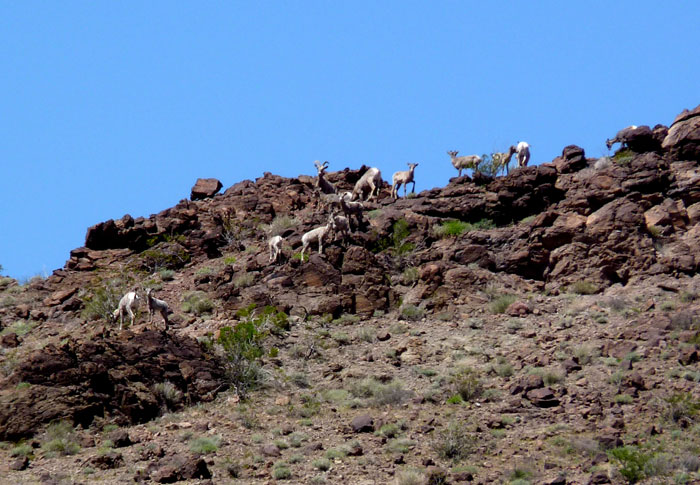
^Bighorn sheep in the Cady Mountains, seen on April 24, 2010, about 3 miles east of transmission lines and project site. At least 21 sheep were observed, including several lambs. Photograph by Dave Martz.
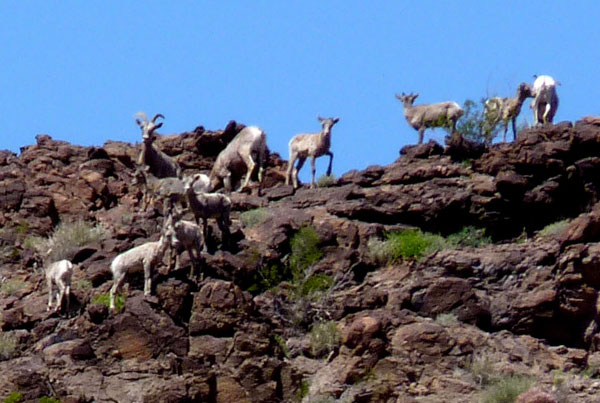
^Detail of photo. Photograph by Dave Martz.
Stirling SunCatcher Technology
<Maricopa Solar LLC project, in Peoria, Arizona (Photo by Chuck Tidd of San Luis Valley Renewable Communities Alliance, Saguache, Colorado).
The proposed Callico Solar project would be a nominal 850-megawatt (MW) Stirling engine project, with about 30,000, 25-kilowatt solar dish Stirling systems (referred to as SunCatchers). Each SunCatcher consists of a solar receiver heat exchanger and a closed-cycle, Solar Stirling Engine specifically designed to convert solar power to rotary power then driving an electrical generator to produce grid-quality electricity.
The proposed project will be constructed on an approximate 8,230-acre site located in San Bernardino County, California, 37 miles east of Barstow. The proposed Cady Mountains Wilderness lies just above the fan site, and Old Route 66 runs along the southern boundary. The proposed Mojave Trails National Monument would begin just to the east of the project.
